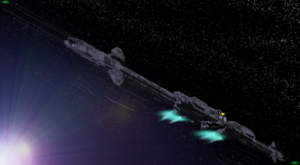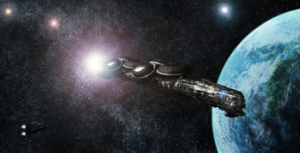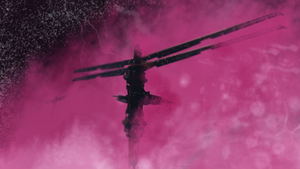Scarabs

Overview
The largest representation of offworlders, the Scarabs perfectly embody the nomadic characterization most of the zero-G-bound Humans have founded over the years. They are a clever bunch, numbering in the millions yet supporting themselves by utilizing advanced compact hydroponics and insect farming to survive and compete in the modern world.
Originating from African Confederation colonists in the early 2200’s, their remarkable history demonstrates the true flexibility and resolve of Humanity. These pioneers, in their early years, banded together with those of other nations launching numerous vessels at similar times for the collective goal of colonizing the depths of space.
History
Tales of lost colonists existed ever since humans first set out to live on the first planet, the most famous one was the disappearance of African Confederation colonists during the early years of Warp travel; the precursor to Bluespace travel. In year 2205 colonists of the Confederation purchased large swathes of land in a yet un-scanned location of deep space in the galactic east. Plenty called this a blunder, but the colonists considered themselves pioneers.
Charmed by promises of the great unknown, of having a land to call their own, and being assured their flight would be completely safe by the shipmaker, Einstein Engines, and the sponsors of several prominent Central African officials, the mission of about 250,000 men, women and children set out. Over the course of several months following, roughly 1,000,000 individuals from a myriad of nations would set out to catch up and join the growing fleet. The struggles of those bygone days was apparent immediately. Their ships had no artificial gravity generator and the design was plagued by issues of clunky, early tech and in the end the colonists paid for it. The colonists’ warp engines sent them out to the coordinates provided, but the clunky engines suffered a catastrophic failure and they were unable to fix the issue, trapping themselves in warp for 12 months of the original 10 month planned trip, throwing them wildly off course into uncharted space.
The engines were finally repaired after weeks of drifting in deep space and they traveled for five more years before unrest broke out., Exhausted colonists wanted to turn back; they reported feeling weak and frail, with physical exercise not enough to prevent the onset of space altering their bodies and turning their children into tall, lanky people.
The captain Kizza Adila was a staunch supporter of Einstein Engines and with her reputation on the line, refused to turn back, fearing what negative press this might cause. Anger against her continued for weeks until eventually the mutineers broke into the bridge. In a panic the captain deleted return coordinates, stranding everyone aboard the ships. The following years are known as “Lost Years”. The ships dissolved into pure chaos. The engineering crew remained alert however, hidden between the plating and the maintenance rooms they kept the ships running for much longer than their intended time without landing. Eventually, a grand-grand-grand son of a Librarian aboard one of the colony ships taught himself how to read and the philosophical and educational books provided him with many ideas and thoughts. And so, Apollo Kagwa united the torn and shattered occupants of long gone civilian departments, who had the lowest ranking in these dire times due to their low importance on the ship maintenance ladder and brought a Holy War, Jihad, onto the ship. But not in the name of destruction but unification.
Instead of bloodbaths and raids he challenged each Captain of each ship and each head of every Department, challenging their posse to a small skirmish, knowing eliminating the leader and his strongest men would ensure his dominance each time. After countless battles over multiple colony ships, they were once again united. During these times they religion shifted and changed, turning into what is now known as Stutuism. Preaching that scarcity is the greatest enemy, that peace and strength is achieved through unity and domination. Not only physical, but also mental and spiritual. It also established who should do what and that each man and woman has their life course set for them, even if they might not know it. They worship a single god and consider every living human an extension of said deity, saying that scarcity and evil exists only to make children into adults, and unwise into the wise.
He preached of Earth and its many bounties, and the people listened, knowing well what they could gain from going back to their old human lifestyles. And so they set course back, back towards the Sol System, their homeland. Now that they’ve arrived, they’ve discovered they’re much too different to integrate fully. Although they’re united, Scarabs still stick to naming their children after the colony ship they inhabit.
The Tian Kehan (an honorary title, vaguely Khan of Heaven) named Iraiya, the fourth successor of Kagwa is the current “leader” of the unified Scarabs. Today, they seek out to unify Humanity - at least those like her own - under a single banner no matter the costs. Among Scarabs, she is known as the Queen in Blue. Scarabs represent an alien form of Man left to itself for nearly two hundred years, independent of all societal progression that guided their hand otherwise. In 2438, Scarabs made their grand return to the Alliance territories, and through trade upgraded their entire home fleet with bluespace technology. Now, their vessels resemble huge inefficient monstrosities of the past intermingled with very advanced bluespace technology. Much of this was obtained through the Techno-Conglomerate, who they maintain excellent relations with to this day.
The Fleet
The Scarab’s home fleet consists of nearly 630 permanent resident vessels with more than 20,000 individuals on board each. A nondescript number of smaller vessels exist, many of which are not permanent residents and simply move with the fleet for safety or business. Here are a few examples of vessels seen in the group.
Mayfly

A ship originated from the Falklands. Colonists from this ship stick to the colors of blue, white and red. They’re primarily caucasian, this ship is known for some of the best engineers and sailors.
An oddity in design, the Mayfly was a failed prototype purchased by Einstein Engines a year after its construction in 2201. The vessel itself was meant to be a garbage swoop originally, mopping Earth’s orbit of its dangerous hyper-accelerated debris. Competitors from Einstein were one step ahead however, and upon purchasing the vessel, it was converted into a heavy-duty freighter. At 1105 meters in width, the vessel resembles a very long, sideways stick with engines strapped on and cargo departments dangling from beneath. Now, almost 50,000 people call it home.
Impukane
A Central African originating ship, the Impukane is known for its cooking and strong security force. The Scarabs from these ships would prefer colors like green, orange and red. People from these ships are primarily Central African.
A largely untouched warp battleship at nearly 730 meters long, the Impukane is one of the largest vessels in the Scarab home fleet. Its intimidating, spikey mass may look dangerous at first glance, but the ship has over time become nothing more than a garrison for much of the official defense force the Scarabs may have. It routinely deploys assistance to fellow vessels for a myriad of reasons and holds a substantial prison wing that contains almost the entirety of the fleet’s own criminals. Its population has plummeted in recent years, now around 65,000.
Fa’Ta-Bs
(Faladay Tadhhab Bsre) is a ship contributed by the Levant. They’re known for their excellent medical practitioners. Their official colors are white, blue and black. People from this ship are usually of Arabic or Jewish descent.
Built with parts sent to space from the largest coil gun ever created, the Fa’Ta-Bs is a marvel of engineering from the 2200’s. The ship itself is relatively small in terms of the fleet, with a population of 11,300, but it also carries the fleet’s foremost medical supplies and response equipment. There are few children if at all kept on board the ship itself, with those on board explicitly being workers for the fleet.
Su-Yeongseon
The Su-Yeongseon is a vessel with roots from eastern Asian, namely Korean descent who had branched off from an international effort to colonize the Antarctic in the early 2200’s. They are well known for their atmospheric manipulation and engineering prowess.
From the newly-founded city designated Sierra Peak, the world’s largest Antarctic colony sprouted an effort to redirect the incredibly advanced environment control and habitation techniques into space. This was seen as a massive success to the Scarabs later down the line, with many of the tricks seen in surviving the harsh tundras now being used to preserve lives on board Scarab vessels. The forefront of this advanced study is the Su-Yeongseon, a large warp cruiser, built in 2197 and now retrofitted for bluespace travel that originally departed with the fleet for defensive purposes. Over time it was converted into an engineering warehouse, with many of its drone bays and missile silos now serving as hangars and storage compartments. The ship itself was built to hold 22,000 people at maximum, but over time has grown to have a population of 42,000 or more with space to spare thanks to modification.

San-Khöl
(Sansryn Khölög) is a Mongolian originating ship. Colonists from this ship primarily enjoy the colors of red, blue, and yellow. They are known for their gardeners, hydroponicists, and scientists. People from this ship are usually of Mongolian or Chinese descent. Built over the course of five years in Ulaanbaatar, the 1100 meter long San-Khöl is an impressive hydroponics vessel. Although capable of holding roughly 25,000 passengers, most of the available space on-board is dedicated to storage of water, food processing, and most importantly the eight hydroponics domes installed onto the ship’s exterior. These are used for fruits, vegetables, and most importantly insects. Three varieties of insect are the most raised here, the Hakhma, a massive beetle the size of a small car. These are utilized for their feed to meat ratio and friendly disposition. Secondly, the Süüs, a variety of honeypot ant that are soda-can sized. These are typically fed cactus juice, which the ant processes into an edible, reportedly tasty and highly nutritious juice, often seen hanging from a Scarab’s belt. Lastly various species of spider, used for their high-strength silk. The ninth dome is entirely devoid of such hydroponics, being used primarily for theatre and entertainment.
Bilröst and the Jormungandr


The CCV Bilröst and Jörmungandr are two ships contributed by the former Scandinavian Coalition. This group was formed around the year 2015 in response to the collapse of the European Union. The countries of Denmark, Norway, and Sweden hastily turned to each other for stability, reforming a modern version of the Scandinavian Monetary Union. Eventually the Bilröst was constructed in the year 2129. However, the plan was malformed. Certain aspects of the ship were under-engineered, certain systems were lacking in redundancies and backups, and an overall lack of strategy regarding reaching the promised land the Confederation had purchased. The addition of the second escort ship, Jörmungandr, only complicated affairs, and not long after their launch, the Scandinavian Coalition was in the red.
With so much of the Coalition’s focus on the new space faring vessels, its people fell to the wayside. Citizens of the Coalition faced food shortages, lack of available healthcare, and an increasing difficulty in finding good work. Times were dark, and with such unpleasant circumstances, there was one thing humans historically turned to - religion.
And it was thus that the people of the Coalition started to look to their old ways.
The people of the Coalition filled themselves with forgotten gods and culture, and it was thanks to this that they gained the strength that they needed to see themselves through adversity. They persevered, worked with what they had, and created the means aboard their new ships to end hunger and heal the sick - and it was in this way that they grew in purpose.
Bilröst
The CCV Bilröst was the first ship constructed by the Scandinavian coalition, and additionally, the center of life for all Asgardians. Though staff here vary from barkeeps to freight movement, the most important activities performed aboard the Bilröst are of the scientific variety, especially with a medical bend. Here, important research is performed to enhance the Offworlder quality of living; musculoskeletal and immune system supplements, different types of bracing equipment, and even the first ESS prototype have undergone development here.
Jörmungandr
The CEV Jörmungandr is a satellite of sorts that accompanies the Bilröst. It is significantly smaller in size, and is only used for non-civilian purposes. The main function of Jörmungandr is to handle and observe security scans to protect the main vessel. Access to the Jörmungandr is normally restricted to capable operators. Typically personnel here are either of an investigative nature, the temporary holding of criminals, or the maintenance and operation of various combat drones.







